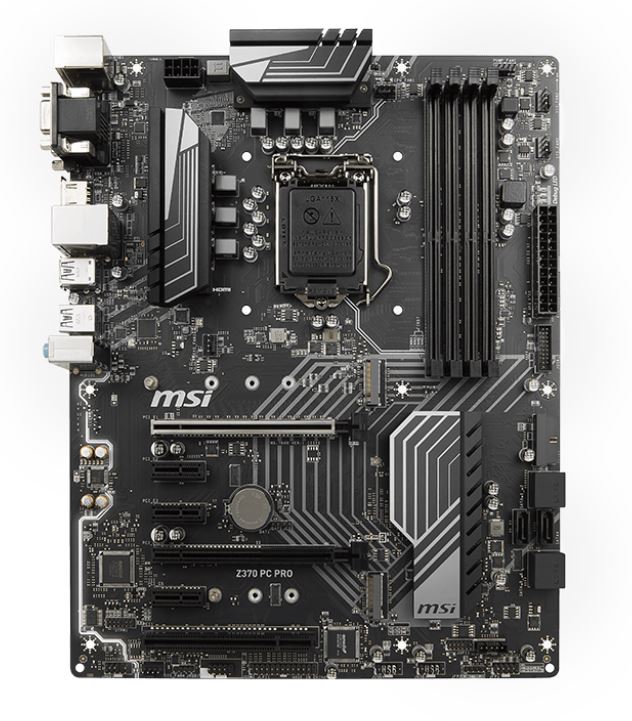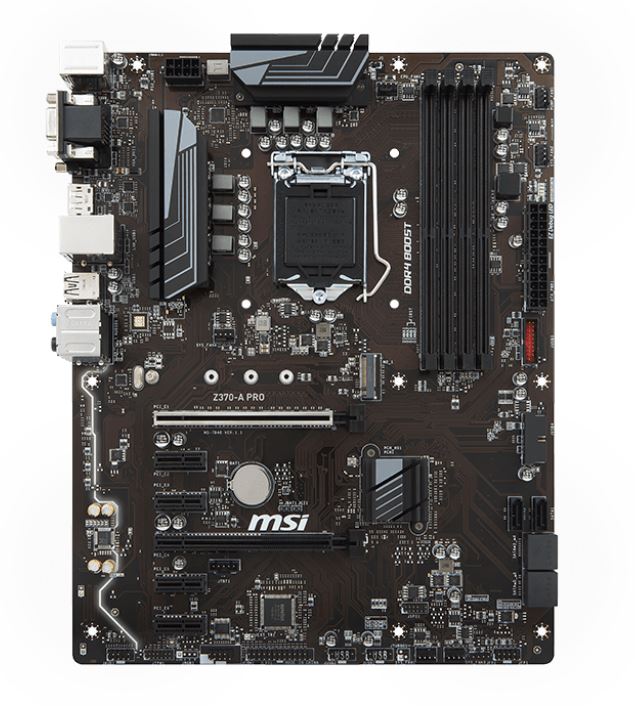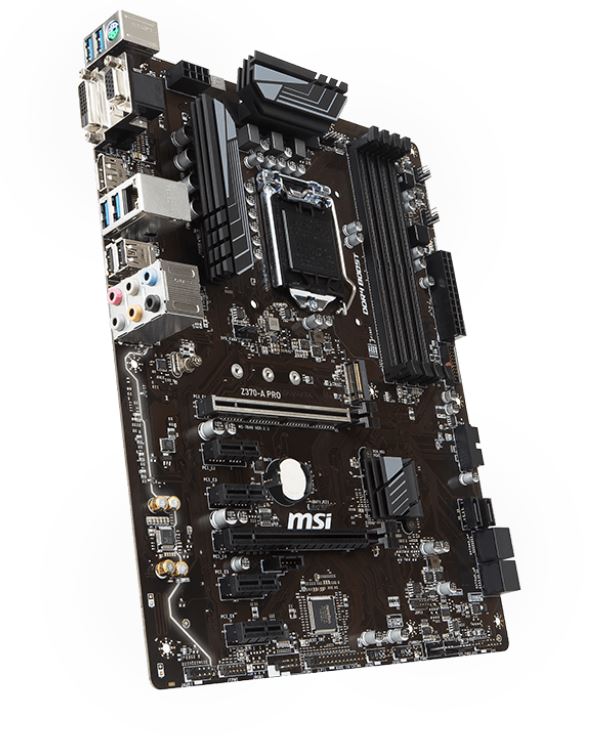Analyzing Z370 for Intel's 8th Generation Coffee Lake: A Quick Look at 50+ Motherboards
by Ian Cutress, Anton Shilov, Joe Shields & Gavin Bonshor on October 20, 2017 2:00 PM ESTMSI Z370 PC Pro and MSI Z370-A Pro
The Pro series consists of two motherboards, the Z370 PC Pro and Z370-A Pro. Both boards use the same six-phase power delivery found in the Gaming Plus. Outside of storage, USB, PCIe support, and the aesthetic differences, both Pro boards keep similar specifications.
The PC Pro goes with a jet black PCB with a silver pattern focused around the chipset heatsink. That same pattern makes its way on the black VRM heatsinks. All the slots and connectors are black with the only reinforced slot being the primary PCIe. Except for the audio separation line, all the RGB LEDs are found on the back of the board creating a glow behind the motherboard. The PC Pro does offer a single RGB header for connecting an RGB strip, enhancing the existing lights.
The Z370-A Pro, on the other hand, is more of a plain brown board with the only patterns on it being the hundreds of visible traces snaking from part to part. The VRM heatsinks, memory slots, and PCIe slots are all black. Like its bigger brother, the first slot is reinforced. The Z370-A Pro uses all white LEDs (no other colors) on the back as well as the audio line. To some users rejoicing, there are no RGB headers on this board.


Z370 PC Pro (left), Z370-A Pro (right)
Memory support on both of the boards is the same, with four memory slots up to 64GB and supported speeds up to DDR4-4000. Both boards have two full-length PCIe slots, the first one being reinforced and x16 from the processor with the second not being reinforced and x4 from the chipset. Where the Z370-A Pro has four PCIe x1 slots, the PC Pro replaces one of them and adds a legacy PCI slot at the bottom.
The Z370-A Pro and PC Pro make the full set of six SATA ports available to users, with four regular placed ports and two vertical, although the layout of where they are is slightly different. The Z370-A Pro has the vertical SATA ports above the other four, while the PC Pro slides the vertical ports between the other four, due to the support of other features.
Fan header count and location are the same on both boards with six 4-pin connectors around the board, four of which are around the chipset. All of these headers support both PWM and voltage control for greater flexibility. For audio and networking, the PC Pro has the ALC887 and Intel I219-V, while the Z370-A Pro has the ALC892 and Realtek TRL8111H. Both boards use Capicon audio caps, and the audio traces are separated from the other portions of the board in an effort to reduce interference.


Z370 PC Pro (left), Z370-A Pro (right)
The PC Pro offers users USB 3.1 (10 Gbps) capabilities through the ASM3142 chipset and offers one Type-C port and one Type-A port on the back panel, while the Z370-A Pro does not offer 10 Gbps support. Both boards offer four eight USB 3.1 (5 Gbps) Type-A ports and two USB 2.0 ports on the back panel. Both boards have a combination PS/2 connector, video outputs, Ethernet, and an audio stack, although the PC Pro uses a HDMI and 2.1 audio, while the Z370-A Pro uses DisplayPort and 7.1 audio. Both boards have D-Sub and DVI-D connectors.
| MSI Z370 PC Pro and A Pro | ||
| Warranty Period | 3 Years | |
| Product Page | Link | Link |
| Size | ATX | |
| CPU Interface | LGA1151 | |
| Chipset | Intel Z370 Express | |
| Memory Slots (DDR4) | Four DDR4 Supporting 64GB Dual Channel Support DDR4 4133+ |
|
| Network Connectivity | 1 x Intel I219-V | 1 x Realtek RTL8111H |
| Onboard Audio | Realtek ALC887 | Realtek ALC892 |
| PCIe (CPU) | 2 x PCIe 3.0 x16 slots @ x16 / x4 | |
| PCIe (PCH) | 1 x PCIe 3.0 x4 3 x PCIe 3.0 x1 |
1 x PCIe 3.0 x4 4 x PCIe 3.0 x1 |
| SATA | 6 x Supporting RAID 0/1/5/10 | |
| Onboard SATA Express | None | |
| Onboard M.2 | 2 x PCIe 3.0 x4 or SATA | 1 x PCIe 3.0 x4 or SATA |
| Onboard U.2 | None | |
| USB 3.1 (10 Gbps) | 1 x Type-C (ASMedia) 1 x Type-A (ASMedia) |
None |
| USB 3.1 (5 Gbps) | 4 x Rear Panel 2 x Headers |
|
| USB 2.0 | 2 x Rear Panel 2 x Headers |
|
| Power Connectors | 1 x 24-pin EATX 1 x 8-pin ATX 12V |
|
| Fan Headers | 1 x 4-pin CPU 1 x 4-pin Waterpump 4 x 4-pin System Fan (All PWM or Voltage controlled) |
|
| IO Panel | 1 x PS/2 keyboard/mouse 1 x VGA port 1 x DVI-D port 1 x HCMI Port 1 x LAN (RJ45) port 4 x USB 3.1 Gen 1 ports 1 x USB 3.1 Gen 2 Type-A 1 x USB 3.1 Gen 2 Type-C 2 x USB 2.0 Type A Audio Jacks |
1 x PS/2 keyboard/mouse 1 x VGA port 1 x DVI-D port 1 x DisplayPort 1 x LAN (RJ45) port 4 x USB 3.1 Gen 1 Type A 2 x USB 2.0 ports Audio Jacks |












83 Comments
View All Comments
sor - Friday, October 20, 2017 - link
Damn. At least key it differently and call it LGA1151v2 or something.The changes are so minimal it really does seem like planned obsolescence. Does it really need more power pins to support new chips with the same power envelopes? Really? They couldn’t handle that on the CPU PCB?
KaarlisK - Saturday, October 21, 2017 - link
Actually it is ~1.5 times peak current with the same average power envelope, so yes, they need the change.If they had not brought the launch forward and just launched together with the cheap chipsets, there would be far less complaints.
sor - Saturday, October 21, 2017 - link
Where did you find information indicating current has increased 50%? I just spent about ten minutes trying to find a reference backing that up, perhaps something indicating the 8 series operates at a much lower voltage within same TDP, which would translate to higher current but they seem to operate in the same 1.2-1.3v range.You’re not just assuming they draw more current because they have two more cores, are you?
KaarlisK - Sunday, October 22, 2017 - link
Notice the difference between average and peak.And the information is in publicly available documents. I did not bother to look it up, but others have, for example: https://forum.beyond3d.com/threads/intel-coffee-la...
Crono - Saturday, October 21, 2017 - link
Nice roundup. That's a lot of motherboards to spec and summarize. I especially appreciate the handy chart at the end, it's a good, quick-and-dirty comparison tool.Landcross - Saturday, October 21, 2017 - link
You guys forgot 2 new Z370 boards from Supermicro :)https://motherboarddb.com/motherboards/?chipset=19...
Xpl1c1t - Sunday, October 22, 2017 - link
The mITX board looks incredible.+ Low ESR Tantalum capacitors! (first time seeing them on VRM duty on a mainboard)
+ HDMI 2.0
+ 2x M.2 Slots
+ USB 3.1 Type C
+ Optical SPDIF
- RGB.......
MadAd - Saturday, October 21, 2017 - link
Great write up but for me its just another depressing generation of oversized, overpriced ATX form factor offerings on which the vast majority of users wont even plug a second gpu into, with the smaller and more size appropriate FF represented as a minority afterthought.With all the progress of PCs since the 90s whod have thought that I could still use the same ATX case today while every single other component (from floppy drives to 2d Mattrox cards) have long gone to the recyclers. I find it so annoying how manufacturers have stuck on this prehistoric gargantuan case size with the other sizes being an afterthought. It feels like like stifled innovation while everything else is moving on.
rocky12345 - Saturday, October 21, 2017 - link
Great article and a lot of work put in to get it out for us to read thank you.My only issue is and it is nit your fault is why these companies feel the need to totally blanket the market with basically the same boards just a different model number and basically a few tiny changes and spray paint it a different color and use the word gaming and put something x or x1 or k,k3 etc etc. For crap sakes just release three models not 7-10 models of the same crap it is pretty much just greed I guess.
The whole market is like this now with anything computer related of and if it has the words GAMING or RGB in it's got to be good for sure. My fav is that gaming mouse pad next it will have RGB lighting in it...lol
CitizenZer0 - Wednesday, October 25, 2017 - link
Agreed